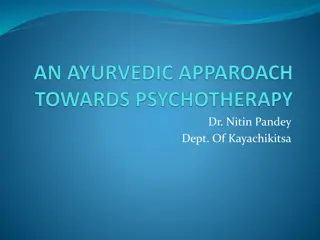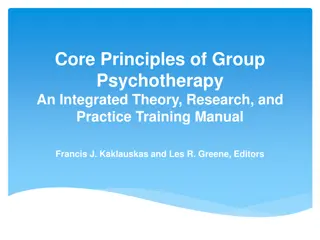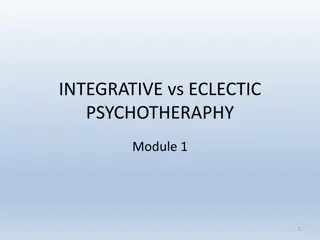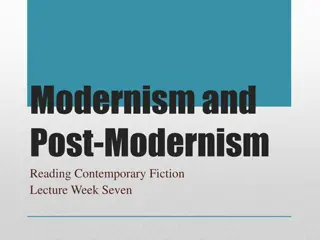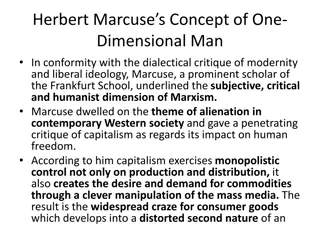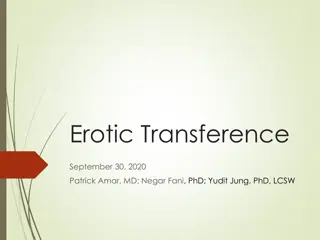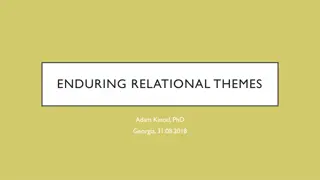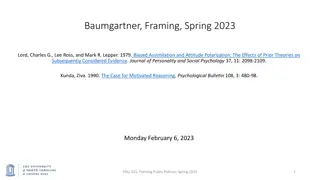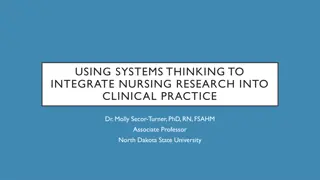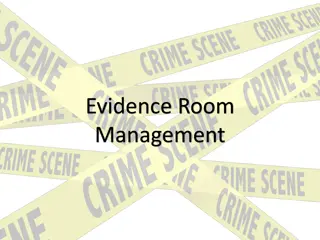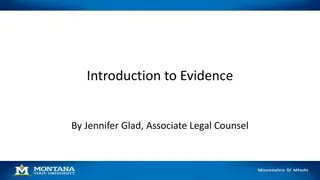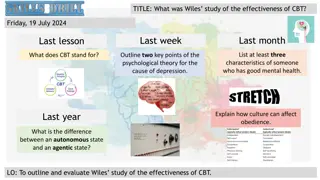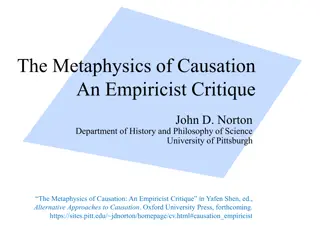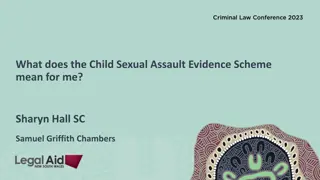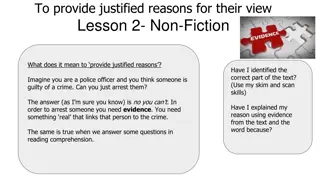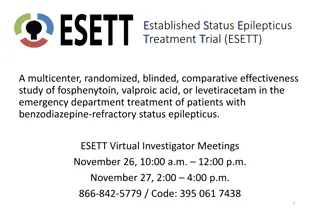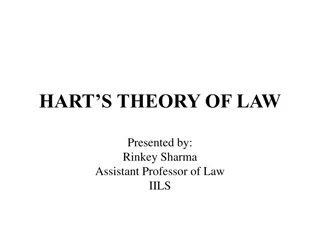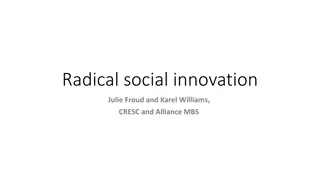Evaluating the Effectiveness of Psychotherapy: Evidence and Critiques
Evidence suggests that psychotherapy works for many individuals, with high satisfaction rates reported. Critics, however, raise concerns about placebo effects, therapist biases, and human biases influencing perceptions of success. Clinicians acknowledge successful cases but remain cautious of cognitive errors. Meta-analysis, a statistical method combining research studies, indicates overall positive outcomes for psychotherapy compared to no treatment.
Download Presentation

Please find below an Image/Link to download the presentation.
The content on the website is provided AS IS for your information and personal use only. It may not be sold, licensed, or shared on other websites without obtaining consent from the author. Download presentation by click this link. If you encounter any issues during the download, it is possible that the publisher has removed the file from their server.
E N D
Presentation Transcript
Learning Targets 72-1 Analyze whether psychotherapy works and discuss how we can make this judgment. 72-2 Discuss which psychotherapies are more effective for specific disorders. 72-3 Discuss how alternative therapies fare under scientific scrutiny. 72-4 Distinguish the three elements shared by all forms of psychotherapy. 72-5 Describe how culture and values influence the therapist-client relationship. 72-6 Discuss what a person should look for when selecting a psychotherapist. Module 72 Evaluating Psychotherapies
What is the evidence that psychotherapy works? In one study, 90% of the 2900 Consumer Reports readers who related their experiences with mental health professionals were at least fairly well satisfied. (1995; Kotkin et al., 1996; Seligman, 1995) Among those who recalled feeling fair or very poor when beginning therapy, 9 in 10 now were feeling very good, good, or at least so-so.
What reasons do critics note to be skeptical of the success of psychotherapy? People often enter therapy in crisis. When the crisis naturally passes, as crises do, people credit the therapy rather than the passing of time. Clients believe that the therapy will help and the placebo effect helps heal the person. Clients generally speak kindly of their therapists even if there are problems or unresolved issues. Clients want to believe the therapy was worth the time and effort.
Do clinicians (psychologists) believe psychotherapy works? There are many case studies of successful psychotherapy. However; therapists, like all humans, are prone to the cognitive errors such as confirmation bias and thus may only perceive the positive client comments that support what the therapist already believes about the therapy. So, like client testimonials, psychotherapist claims may also be subject to human bias. As with other enduring questions, psychologists turn to research.
What is meta-analysis? a procedure for statistically combining the results of many different research studies Simply said, meta-analyses give us the bottom-line result of lots of studies. Rather than conducting one study, researchers look through the results of dozens, even hundreds of similar studies and summarize the data using statistics to paint a larger picture.
What does meta analysis show about the success of psychotherapy? These two normal distribution curves based on data from 475 studies show the improvement of untreated people and psychotherapy clients.
1. What Would You Answer? Meta-analysis is A. a drug study based on a small sample. B. a treatment versus no treatment group. C. a tendency for smaller scores to move toward the average. D. regressing from unusual to usual. E. a way to combine the results of many studies.
So, the verdict is? Dozens of subsequent summaries have now examined psychotherapy s effectiveness. Those not undergoing therapy often improve, but those undergoing therapy are more likely to improve and to improve more quickly and with less risk of relapse. (Kolovos et al., 2017; Weisz et al., 2017) Many people exhibit a more stable and outgoing personality after therapy. (Roberts et al., 2017)
Which disorders respond favorably to therapy? The more specific the problem, the greater the hope that psychotherapy might solve it. (Singer, 1981; Westen & Morrison, 2001) Those who experience phobias or panic or who are unassertive, can hope for improvement. Those with less-focused problems, such as depression and anxiety, usually benefit in the short term but often relapse later.
Which therapies seem most effective with which disorders? Cognitive and cognitive-behavioral therapies anxiety, posttraumatic stress disorder, insomnia, and depression. (Qaseem et al., 2016; Scaini et al., 2016; Tolin, 2010) Behavioral conditioning therapies specific behavior problems, such as bed-wetting, phobias, compulsions, marital problems, and sexual dysfunctions. (Baker et al., 2008; Hunsley & DiGiulio, 2002; Shadish & Baldwin, 2005)
Which additional therapies seem most effective with which disorders? Psychodynamic therapy depression and anxiety (Driessen et al., 2010; Leichsenring & Rabung, 2008; Shedler, 2010b). Nondirective (client-centered) counseling mild to moderate depression (Cuijpers et al., 2012).
What is evidence-based practice? clinical decision making that integrates the best available research with clinical expertise and patient characteristics and preferences Endorsed by the American Psychological Association and others, therapists using this approach integrate the best available research with clinical expertise and with patient preferences and characteristics. After rigorous evaluation, clinicians apply therapies suited to their own skills and their patients unique situations.
What is evidence-based clinical decision making? The ideal clinical decision making can be visualized as a three-legged stool, upheld by research evidence, clinical expertise, and knowledge of the patient.
What is eye movement desensitization and reprocessing (EMDR)? EMDR (eye movement desensitization and reprocessing) is a therapy adored by thousands and dismissed by thousands more as a sham. During EMDR therapy, the client pulls back traumatic memories and simultaneously focus on external stimuli, such as the therapists waving finger, or an external focal point. Skeptics acknowledge that EMDR does work better than doing nothing. (Lilienfeld & Arkowitz, 2007)
What do skeptics state about the alternative therapy EMDR? Studies indicate that EMDR is just as effective with fixed eyes. If that conclusion is right, what s useful in the therapy (chiefly behavioral desensitization) is not new, and what s new is superfluous. ~Harvard Mental Health Letter, 2002 Skeptics suspect that what is therapeutic is not the eye movements, but the combination of exposure therapy repeatedly calling up traumatic memories and reconsolidating them in a safe and reassuring context and perhaps some placebo effect.
What is light exposure therapy? National Institute of Mental Health researchers in the early 1980s had an idea: give people a timed daily dose of intense light. Sure enough, people reported they felt better.
What research has been conducted on light exposure therapy? One study exposed some people with a seasonal pattern in their depression symptoms to 90 minutes of bright light and others to a sham placebo treatment a hissing negative ion generator that was just producing white noise. After four weeks, 61% of those exposed to morning light had greatly improved, as had 50% of those exposed to evening light and 32% of those exposed to the placebo. (Eastman et al., 1998)
So, the verdict is Studies have shown that 30 minutes of morning exposure to 10,000-lux white fluorescent light produces relief for most depressed people.
2. What Would You Answer? Trevor spends 45 minutes a day in front of an intense light. It is most likely that he is being treated with A. cognitive therapy. B. light therapy. C. EMDR therapy. D. rational-emotive behavior therapy. E. psychodynamic therapy.
What three benefits do all psychotherapies share? Hope: any psychotherapy offers the expectation that, with commitment from the therapy seeker, things can and will get better. A new perspective: every therapy offers people a plausible explanation of their symptoms. An empathic, trusting, caring relationship: effective therapists are empathic. They seek to understand the client s experience. They communicate care and concern, and they earn trust through respectful listening, reassurance, and guidance.
What is a therapeutic alliance? a bond of trust and mutual understanding between a therapist and client, who work together constructively to overcome the client s problem
What should a person look for when selecting a therapist? A person seeking therapy may want to ask about the therapist s treatment approach. A person seeking therapy may want also want to ask about the therapist s values. It is also important to ask about the therapist s credentials and how much the therapist charges.
How does culture impact the client-therapist relationship? In North America, Europe, and Australia, for example, most psychotherapists reflect their culture s individualism, which often gives priority to personal desires and identity. Clients with a collectivist perspective, as with many from Asian cultures, may assume people will be more mindful of social and family responsibilities, harmony, and group goals. These clients may have trouble relating to therapies that require them to think only of their own well-being. (Markus & Kitayama, 1991)
Why might clients not seek therapy? People living in cultures of honor prize being strong and tough. They may feel that seeking mental health care is an admission of weakness rather than an opportunity for growth. (Brown et al., 2014) Some minority groups tend to be both reluctant to seek therapy and quick to leave it. (Chen et al., 2009; Sue et al., 2009)
Why might the therapist and the client be mismatched? Client-psychotherapist mismatches may also stem from religious values. Highly religious people may prefer and benefit from religiously similar therapists, and may have trouble forming an emotional bond with one who does not share their values. (Masters, 2010; Pearce et al., 2015)
Think about it. How might your culture and values influence the sort of therapy you would welcome or your willingness to seek therapy at all? Write down your thoughts and share with the class.
When should a person seek therapy? The American Psychological Association offers these common trouble signals.
Learning Target 72-1 Review Analyze whether psychotherapy works and discuss how we can make this judgment. Clients and therapists positive testimonials cannot prove that therapy is actually effective, and the placebo effect makes it difficult to judge whether improvement occurred because of the treatment. Using meta-analyses researchers have found that those not undergoing treatment often improve, but those undergoing psychotherapy are more likely to improve more quickly and with less chance of relapse.
Learning Target 72-2 Review Discuss which psychotherapies are more effective for specific disorders. No one type of psychotherapy is generally superior to all others. Therapy is most effective for those with clear-cut, specific problems. Some therapies such as behavior conditioning for treating phobias and compulsions are more effective for specific disorders.
Learning Target 72-2 Review cont. Discuss which psychotherapies are more effective for specific disorders. Psychodynamic therapy has helped treat depression and anxiety, and cognitive and cognitive-behavioral therapies have been effective in helping people cope with anxiety, posttraumatic stress disorder, insomnia, and depression. Evidence-based practice integrates the best available research with clinicians expertise and patients characteristics, preferences, and circumstances.
Learning Target 72-3 Review Discuss how alternative therapies fare under scientific scrutiny. Controlled research has found some benefits of eye movement desensitization and reprocessing (EMDR) therapy for PTSD, though possibly for reasons unrelated to eye movements. Light exposure therapy does seem to help those with a seasonal pattern in their depression symptoms by activating a brain region that influences arousal and hormones.
Learning Target 72-4 Review Distinguish the three elements shared by all forms of psychotherapy. All psychotherapies offer new hope for demoralized people; a fresh perspective; and (if the therapist is effective) an empathic, trusting, and caring relationship. The emotional bond of trust and understanding between therapist and client the therapeutic alliance is an important element in effective therapy.
Learning Target 72-5 Review Describe how culture and values influence the therapist-client relationship. Therapists differ in the values that influence their goals in therapy and their views of progress. These differences may create problems if therapists and clients differ in their cultural, gender, or religious perspectives.
Learning Target 72-6 Review Discuss what a person should look for when selecting a psychotherapist. A person seeking therapy may want to ask about the therapist s treatment approach, values, credentials, and fees. An important consideration is whether the therapy seeker feels comfortable and able to establish a bond with the therapist.


